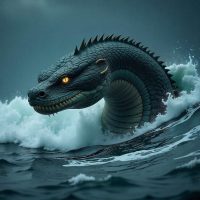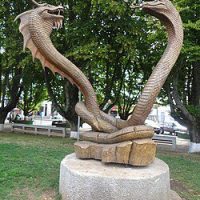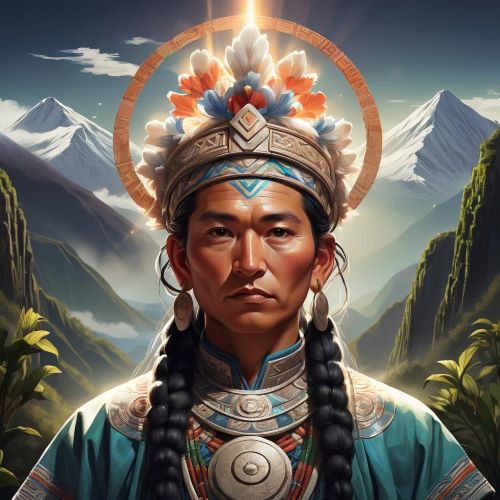Cai Cai-Vilu : The Serpent of the Sea in Mapuche Mythology
Listen
At a glance
| Description | |
|---|---|
| Origin | Mapuche Mythology |
| Classification | Gods |
| Family Members | N/A |
| Region | Chile |
| Associated With | Rain |
Cai Cai-Vilu
Introduction
Cai Cai-Vilu, also written as Coi Coi-Vilu or Caicai Vilu, stands as one of the most influential figures in Mapuche mythology, revered as the supreme serpent of the sea and guardian of all aquatic realms. In Mapudungun, “Vilu” signifies serpent, while “Cai/Coi” expresses the nature of water, creating a name that captures the essence of a vast and commanding water deity. Among the Mapuche of Chile and Argentina, this giant serpent embodies the unstoppable power of the ocean, capable of reshaping coasts, drowning valleys, and filling the world with life or peril.
The most enduring tale of Cai Cai-Vilu is the cosmic struggle against its counterpart, Ten Ten-Vilu, the serpent of the earth. In their mythic clash, Cai Cai-Vilu attempts to reclaim the land by raising the seas, while Ten Ten-Vilu lifts the mountains to protect humans and animals. This legendary battle is at the heart of the origin story of the Chiloé Archipelago, a region marked by fjords, islands, and unpredictable tides—all believed to be remnants of this epic confrontation. Through this myth, the Mapuche explain both the beauty and the danger of their watery landscapes, seeing them as the living signatures of divine conflict.
Physical Traits
Cai Cai-Vilu is consistently described as a massive serpent whose body spans the length of coastlines and hides beneath the waves. Its size is such that a single movement is enough to disturb the sea, generating surges and waves that reshape the land. Many stories portray the serpent as an aquatic being with sleek, powerful scales and a presence that blends seamlessly with the ocean itself. Some later Chilote interpretations add horned features or fin-like shapes, emphasizing its absolute dominion over the water.
In traditional accounts, this serpent does not resemble any ordinary creature. Instead, it represents the vastness of the sea—an entity whose breath stirs the tides, whose anger rouses storms, and whose rising can swallow entire regions. Its terrifying beauty and unfathomable scale reflect the Mapuche understanding of nature as a force that commands respect rather than fear, a living entity whose moods dictate the fate of those who inhabit the coast.
Family
The lineage of Cai Cai-Vilu links it directly to the elemental forces that govern Mapuche cosmology. Many traditions describe the serpent as the child of Peripillán (or Pien-Pillán), a fiery spirit associated with volcanoes and destructive energy. This origin connects water and fire within a single mythic family, illustrating the Mapuche view that natural elements coexist in both tension and complementarity.
Correspondingly, Ten Ten-Vilu is often described as the offspring of Antu, a celestial or solar spirit. Their rivalry, therefore, is not random but emerges from a deeper cosmic relationship between sea, earth, sky, and fire. Such genealogies reveal how the Mapuche used myth to articulate the balance between natural forces, understanding their landscapes as shaped by the interactions of divine beings whose conflicts were as formative as they were symbolic.
Other names
Cai Cai-Vilu appears under several names across Mapuche and Chilote traditions. Spellings such as Coi Coi-Vilu, Caicai Vilu, Kaykayfilu, and Coicoi-Vilu all reference the same deity, with variations stemming from regional dialects and Spanish transcription. The core components remain unchanged: “Kaykay/Cai Cai,” the divine name, and “Vilu,” meaning serpent.
Some versions from Chiloé even shift the deity’s gender, referring to Cai Cai-Vilu as female and emphasizing maternal power over the sea. In Chilean popular culture and educational texts, the deity is sometimes glossed as the “serpent of the sea” or “goddess of the waters,” interpretations that reinforce its association with aquatic sovereignty while contributing to its modern identity.
Powers and Abilities
As the ruler of the oceans, Cai Cai-Vilu possesses complete control over all waters, from the deep sea to rivers, lakes, and tidal zones. Its most feared ability is the power to raise the sea level, unleashing great floods that swallow land and remind humans of their vulnerability. During its legendary battle with Ten Ten-Vilu, this power became the driving force behind the drowning of valleys and the disappearance of once-continuous territories.
Cai Cai-Vilu also governs marine creatures, commanding spirits, animals, and mythical beings that inhabit the depths. Its authority explains why the sea is both a source of livelihood and danger—a realm governed by a deity whose moods determine safety. The serpent’s influence extends to geological formation. The fjords, cliffs, islands, and rugged coasts of southern Chile are understood as the scars left by its cosmic struggle: drowned valleys where the serpent prevailed and high mountains raised by Ten Ten-Vilu in resistance.
In many narratives, Cai Cai-Vilu remains active even today, manifesting in storms, tidal anomalies, and tsunamis. These natural events are interpreted as echoes of the serpent’s enduring presence, reinforcing its role as an ever-watchful keeper of the sea.
Modern Day Influence
Today, Cai Cai-Vilu continues to shape cultural identity, regional storytelling, and modern interpretations of environmental balance. In Chiloé and southern Chile, the myth remains foundational, retold in schools, festivals, local art, and tourism narratives. The story is often invoked when discussing earthquakes, tsunamis, and the volatile coastal geography of the region, connecting scientific explanations with ancestral memory.
The serpent also appears in contemporary media. In the Chilean animated film Nahuel and the Magic Book, Cai Cai-Vilu rises dramatically from the ocean, demonstrating how mythological beings continue to inspire modern storytelling. Scientists have also honored the myth by naming prehistoric marine reptiles such as Kaikaifilusaurus and Kaikaifilu after the deity, bridging mythology with paleontology.
Environmental movements increasingly draw upon the symbolism of Cai Cai-Vilu, using the water serpent as a reminder of equilibrium between land and sea and the importance of respecting natural forces. In this sense, Cai Cai-Vilu serves not merely as a myth but as a cultural metaphor for resilience and ecological awareness.
Related Images
Source
Earthstoriez. (2025). Chile: Legends from Chiloé. Retrieved November 25, 2025, from https://earthstoriez.com/legends-chiloe-chile
Milkaos. (n.d.). Ten Ten Vilu y Coi Coi Vilu. Retrieved November 25, 2025, from https://milkaos.cl/mitologia_tenten%20vilu_coicoi%20vilu.html
Proyecto Webescuela. (n.d.). Mito Tren tren y Cai cai vilú (educational resource). Retrieved November 25, 2025, from Webescuela platform.
Wikipedia. (n.d.). Coi Coi-Vilu. In Wikipedia. Retrieved November 25, 2025, from https://en.wikipedia.org/wiki/Coi_Coi-Vilu
Wikipedia. (2024, September 15). Legend of Trentren Vilu and Caicai Vilu. In Wikipedia. Retrieved November 25, 2025, from https://en.wikipedia.org/wiki/Legend_of_Trentren_Vilu_and_Caicai_Vilu
Wikipedia. (n.d.). Ten Ten-Vilu. In Wikipedia. Retrieved November 25, 2025, from https://en.wikipedia.org/wiki/Ten_Ten-Vilu
Foerster, R. (1993). Introducción a la religiosidad mapuche. Santiago de Chile: Ediciones Universidad de Chile.
Bacigalupo, A. M. (2016). Thunder Shaman: Making history with Mapuche spirits in Patagonia. Austin, TX: University of Texas Press.
Frequently Asked Questions
Who is Cai Cai-Vilu in Mapuche mythology?
Cai Cai-Vilu is the serpent deity of the sea, responsible for floods and the creation of the Chiloé Archipelago.
What is the story of Cai Cai-Vilu and Ten Ten-Vilu?
Their legendary battle between sea and earth explains the formation of mountains, valleys, and islands in southern Chile.
Is Cai Cai-Vilu considered male or female?
Most Mapuche sources describe Cai Cai-Vilu without fixed gender, while some Chilote traditions depict the serpent as female.
What powers does Cai Cai-Vilu possess?
The deity controls all waters, marine creatures, floods, storms, and the shaping of coastal geography.
How is Cai Cai-Vilu represented in modern culture?
Cai Cai-Vilu appears in regional folklore, festivals, films, scientific names, and environmental symbolism across Chile.









